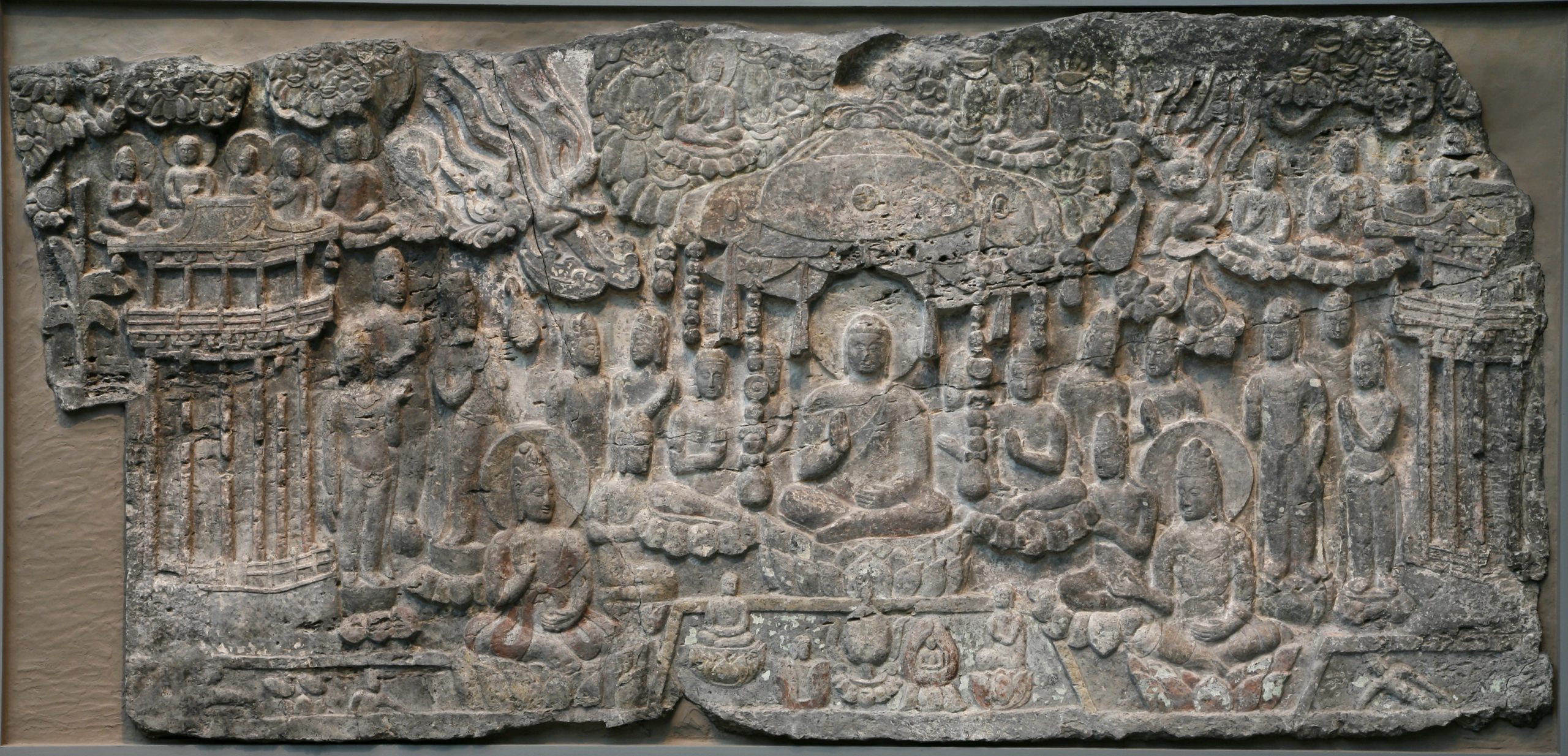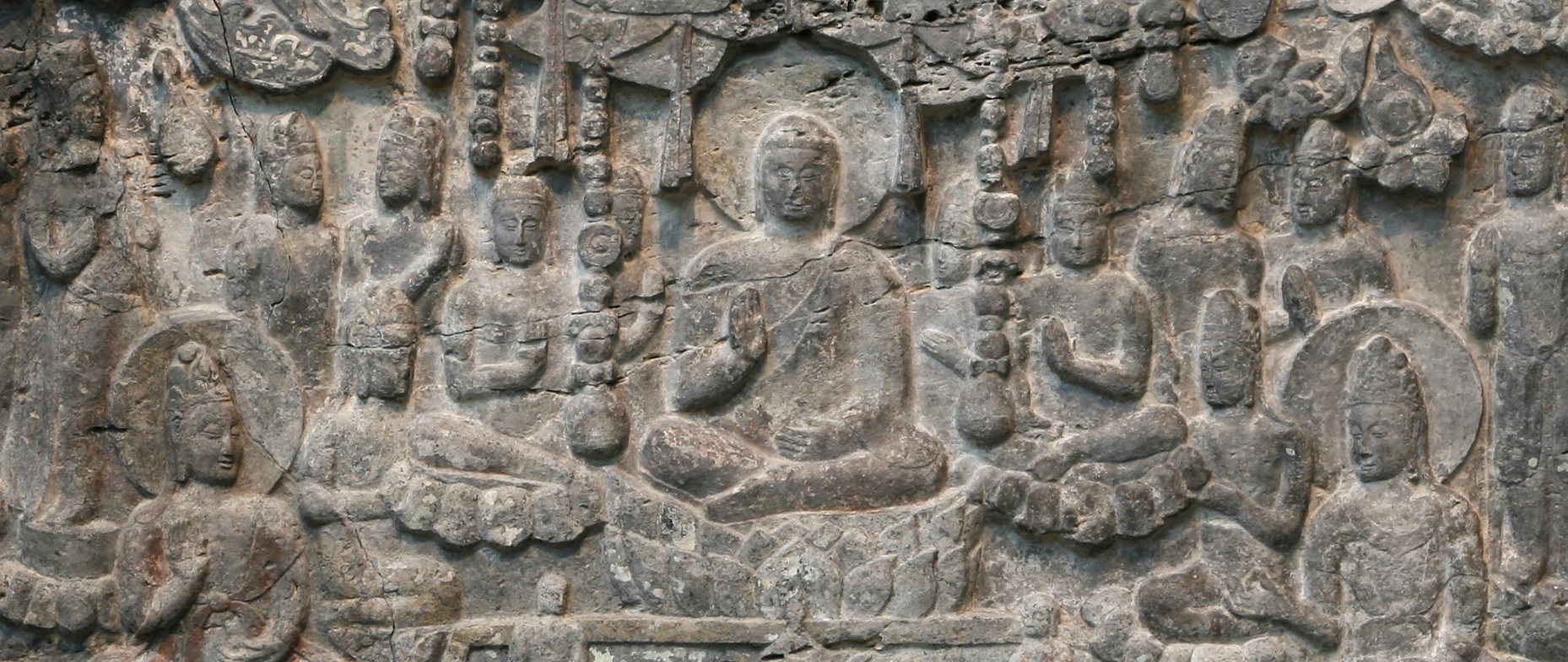Amitabha(ah-me-tah-bah) literally, “Infinite Light”; the Buddha of the Western Paradise. Widely revered in Mahayana Buddhist traditions, Amitabha enables his followers to be born into his paradise and attain Buddhahood in one lifetime.: literally, “Infinite Light”; the Buddha(bood-huh) literally, “Awakened One”; a being who has awakened to the true reality of existence and is thereby liberated from the cycle of birth, death, and rebirth. A Buddha teaches others the path to Enlightenment. of the Western Paradise. Widely revered in Mahayana(mah-huh-uah-nuh) a path of Buddhism that offers salvation to all and allows popular worship. Buddhist traditions, Amitabha enables his followers to be born into his paradise and attain Buddhahood in one lifetime.
Avalokiteshvara(ah-vuh-low-kee-taysh-vuh-ra) literally, “The Lord who Looks Down [from on High]”; the widely worshipped bodhisattva of compassion who protects and saves all beings.: literally, “The Lord who Looks Down [from on High]”; the widely worshipped bodhisattva(bo-dee-saht-vah) an enlightened being who chooses not to proceed to Nirvana but instead remains on earth to guide others in their paths toward enlightenment. of compassion, who protects and saves all beings.
bodhisattva: an enlightened being who chooses not to proceed to Nirvana(ner-vah-nuh) a spiritual state of perfect peace beyond selfish attachments to worldly possessions; reaching Nirvana frees one’s soul from the Buddhist cycle of birth, death, and rebirth. but instead remains on earth to guide others in their paths toward enlightenmenta moment of great wisdom and understanding; the highest level of consciousness, believed to be achieved through meditation and adhering to the basic moral teaching of Buddhism..
Buddha: literally, “Awakened One”; a being who has awakened to the true reality of existence and is thereby liberated from the cycle of birth, death, and rebirth. A Buddha teaches others the path to Enlightenment.
deva(day-vuh) literally, “divinity,” “heavenly being”; the most pleasure-filled among five rebirth destinies. Rebirth as a deva is granted for good deeds performed during the previous lifetime.: literally, “divinity,” “heavenly being”; the most pleasure-filled among five rebirth destinies. Rebirth as a deva is granted for good deeds performed during the previous lifetime.
dharma(dar-muh) the Buddha’s teachings or doctrines.: the Buddha’s teachings or doctrines.
Enlightenment: a moment of great wisdom and understanding; the highest level of consciousness, believed to be achieved through meditation and adhering to the basic moral teaching of Buddhism(bood-ihz-uhm) a widespread Asian religion or philosophy founded by Siddartha Gautama in northeastern India in the 5th century BCE..
kalpa(kahl-puh) literally, “age”; a period of time spanning four different stages of the universe: formation, existence, destruction, and non-existence. This period is composed of many intermediate kalpas.: literally, “age”; a period of time spanning four different stages of the universe: formation, existence, destruction, and non-existence. This period is composed of many intermediate kalpas.
Mahasthamaprapta(mah-hah-stah-mah-prahp-tah) literally, “One who Has Attainted Great Power”; a bodhisattva who represents wisdom. He is usually depicted with Buddha Amitabha and bodhisattva Avalokiteshvara. His crown is often decorated with a small water vessel.: literally, “One who Has Attainted Great Power”; bodhisattva who represents wisdom. He is usually depicted with Buddha Amitabha and bodhisattva Avalokiteshvara. His crown is often decorated with a small water vessela container such as a cup, bowl, pot, or dish..
Nestorianisma Christian sect that originated in Asia Minor and Syria around the fifth century CE.: a Christian sect that originated in Asia Minor and Syria around the fifth century CE.
Nirvana: a spiritual state of perfect peace beyond selfish attachments to worldly possessions; reaching Nirvana frees one’s soul from the Buddhist cycle of birth, death, and rebirth.
Pure Landalso called Western Paradise, or in Sanskrit as Sukhavati; one of the auspicious places in which to be reborn.: also called Western Paradise, or in Sanskrit as Sukhavati; one of the auspicioussuccessful or prosperous; a sign of future success places in which to be reborn.
Siddhartha Gautama(sihd-dahr-tuh gaw-tuh-muh) the given name of Shakyamuni, literally “Sage of the Shakya Clan,” the Historical Buddha. He lived in northeastern India sometime after the fifth century BCE.: the given name of Shakyamuni(Shah-kya-moo-knee) literally, “Sage of the Shakya Clan”; the Historical Buddha. His given name was Siddhartha (sid-har-ta) Gautama. He lived in northeastern India sometime after the fifth century BCE., literally “Sage of the Shakya Clan,” the Historical Buddha. He lived in northeastern India sometime after the fifth century BCE.
three evilsgreed, hate, ignorance.: greed, hate, ignorance.
Upata(oo-pah-tuh) literally, “exuberance,” “satiety.”: literally, “exuberance,” “satiety.”








